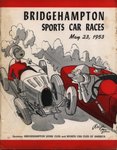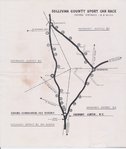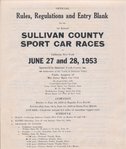 Narrowsburg
NarrowsburgLight Rain Fog/Mist, 43°
Wind: 8.1 mph
 Narrowsburg
NarrowsburgFREMONT CENTER, NY — On June 26 through 28, 1953, the western part of Sullivan County hosted what, in the official souvenir program, was billed as the “Sullivan County Sport Car Races of …
Stay informed about your community and support local independent journalism.
Subscribe to The River Reporter today. click here
This item is available in full to subscribers.
Please log in to continue |




FREMONT CENTER, NY — On June 26 through 28, 1953, the western part of Sullivan County hosted what, in the official souvenir program, was billed as the “Sullivan County Sport Car Races of June 28, 1953.”
Sullivan County Historian John Conway wrote about the race in his column “Retrospect” in a story titled “The Fabulous Callicoon Sport Car Races” dated November 7, 2008 and published in the area’s twice-a-week newspaper.
“It happened only once, but for that weekend it thrust western Sullivan County into the center of the sports car racing world,” wrote Conway. “It went off virtually without a hitch, and one expert said afterward that the race route could have become the best in the country, but the event was never repeated.”
It was a non-sanctioned motorsports race sponsored by the Delaware Youth Center in Callicoon under the auspices of the Jersey Sport Car Club, Inc. in cooperation with the Connecticut Sports Car Club, Long Island Sport Car Owners Association, MG Car Club, Westchester County Sport Car Club and the Motor Sport Car Club of New York (not all of the cooperating clubs were listed in the official program).
In early spring of 1952, the local youth center formed a race committee to explore the feasibility of holding the race, petitioned the NYS Department of Public Works (DPW) for a green light and began negotiating with the Sports Car Club of America (SCCA) to obtain regional sponsorship.
The SCCA was founded in 1944 as the leading sanctioning organization for road racing, rallying and autocross in the United States, reportedly declined to endorse the local event as it deemed it too risky to hold on public roads, even though they were closed to traffic on race day.
As things moved along the pothole-filled bureaucratic highway, DPW nixed the idea, and despite initially favorable reactions from the SCCA, the New York Region threw a monkey wrench into the works by declining to officially back the race.
In Conway’s “Retrospective” article, he quoted Bill Green, a historian with International Motor Racing Club Research Center at Watkins Glen, NY as recalling the SCCC “discouraged its members from racing because it considered the course too treacherous.”
Rubber meets the road
The schedule of events started on Friday, June 26, 1953 with the first round of technical inspections of the contestant’s cars at Carl’s Motor Sales in Callicoon, NY.
On Saturday, June 27, the morning began with tech inspections, followed by a driver’s meeting at the Western Hotel, and concluded in the afternoon with practice runs on the Fremont Center road course.
The first race was all-MG and, according to the program, listed 20 entrants in the Fremont Center Race, with drivers registering from their hometowns in New York and New Jersey.
The second event was titled the Callicoon Trophy Race and featured a total of 20 cars spanning a variety of marques, the more notable of which included a Fiat-Zagato, a Jowett Jupiter, a Multiplex, as well as MGs, Singers and Porsches.
Third up was the Delaware Valley Trophy Race with 18 cars listed on the program, covering a wide range of marques: a Jowett Jupiter, MG Specials, Porsches, a couple of Siata and an ultra-rare BMW 328, examples of which, in 2020, can fetch into seven-figures at auction.
The fourth scheduled race was called the Sullivan County Trophy Race and featured a small field of eight cars; seven Jaguars and a lone Altemus driven by J.D. Altemus of New York City.
During the first race of stock MGs, two of them got pranged up in the twisties between Obernberg and Fremont Center. The accident caused a delay, which resulted in two of the classes to be combined into one event
After the races of Sunday, June 28, the entrants attended what was advertised as a “friendship hour” at the casino of the Tennanah Lake House, a victory dinner and the presentation of well-won trophies.
Locals recall the Sullivan County sport car races
While many of the drivers and spectators have passed into the mists of motorsports history, several folks who witnessed the event shared their recollections of the unique road race or provided background information.
Walter Sipple was a teenager back in 1953, attending Delaware Valley Central School when he and a few of his high school buddies pitched in to set up bales of hays along hazardous sections of the racecourse.
“We had to move a lot of bales of hay and set them up where the turns were. They were pretty sharp turns,” recalled Sipple.
“At that age, I was very interested in the cars... They were mostly MGs and a couple of Jags, they weren’t racing each other but in a time thing, in the same class,” recalled the now 83-year-old.
“The track started up by Arnie’s Scrounge Lounge, went all the way up the mountain, crossed into Obernberg, down County Road 93, across to 91, and down into Fremont Center. As kids, we were excited to see these guys show up.”
Back in the day, Arnie’s was famous as a neighborhood watering hole and bore witness to a lot of local folks sitting side-by-side with some of the city’s literary giants seeking a quiet refuge from the hectic life of the Big Apple.
And believe me, even on the cusp of the downside of history, it was quite a ride—right up until Arnie’s faded into oblivion a few years ago.
What young man wouldn’t like a ride in the shotgun seat of an Allard racecar?
Walt Sipple wasn’t about to turn down the offer of a ride around the course in a flaming red Allard, a British-made racer, most likely powered by a V8 Cadillac engine.
In essence, the Allard was a forerunner to Carroll Shelby’s famed AC Cobra that matched up British AC roadsters with Ford 289 engines (later fitted with 428 powerplants) or the Sunbeam Tiger, another English car stuffed with an American V8.
“I saw this thing right away, and said ‘that’s pretty sleek looking,’” recalled Sipple. “It was definitely racecar when you looked at it. One day, when I was really looking at it up close, the driver said, ‘Would you like a ride, kid?’
“It was quite an exciting day, there were a lot of people there, a big crowd. It could have developed into something more... a lot of the old-timers, they’re all gone now.”
Sipple graduated from Delaware Valley High School in 1955 and, after a three-year hitch in the U.S. Army, went on to serve as a town judge for 22 years, followed by stints as the town supervisor.
A long-time member of the Upper Delaware Volunteer Ambulance Corps, he is still active with the local volunteer fire department.
Mary Curtis recalled, “I do remember that it was a big deal in Callicoon and along the race route,” she said, who as 12-year watched the 1953 sport car race from the sidelines with her folks.
Mary Edith Curtis’s family has been in the Upper Delaware River Valley going on two-and-a-half centuries, and over the years left her own mark on local history, both as a noted storyteller teller, a term she prefers to ‘historian’, and as a noted chronicler of past events.
She is a founding member of the Cochecton Preservation Society, served as a member of the Equinunk Historical Society, was Folk Arts Chairman for the Delaware Valley Arts Alliance (DVAA), and after working with the National Park Service (NPS) at the Upper Delaware Scenic & Recreational River (UPDE in NPS speak), first as a public affairs specialist until being appointed park historian.
In 1978 she followed in the footsteps of her father Valleau Curtis as the Town of Delaware Historian, and in 2001 was honored by the Sullivan County Historical Society as the recipient of their History Preserver Award, and retired a while back and currently lives in Maryland.
“I seem to recall that Dr. Rumble was involved in organizing it, I think it was designed to be a benefit…,” said Curtis in a recent email reply asking her for a few memories about the race.
“As I recall, Fred Perdue of Purdue Poultry was the big celebrity guest, providing chicken for the barbecue at the youth center field… For some reason, I remember something about the challenging route of the race, especially that turn in the road near Sky Top when they headed toward Obernberg.”
“I know I’m showing my age, but I remember that race,” Curtis said in an email to Sullivan County Historian John Conway, adding, “As I recall, I was posted with my parents (along the course) to make sure people and cars didn’t get in the way of the race, as the turn was made for Obernberg. I also have a visual memory of some fancy sports cars parked in front of the Western Hotel…Dr. Rumble and Fred Stark were the big protomers of the event, locally.”
Bill Buddenhagen hails from the family that once owned the local Dodge dealership in nearby Hortonville, and as a teenager attending Delaware Valley High School, watched the race from a mountaintop overlooking the racecourse, joined by his uncle and aunt, along with their two daughters.
He said at the time his father Anthony owned the associate Dodge dealership under Gonzalez Motors of Monticello and later passed it along to David Buddenhagen and his wife several years down the road.
“I went up on the hill and watched it from up on the Horning Farm,” Buddenhagen recollected from almost seven decades ago, “We waited for them to come back down around on Obernberg into Fremont.
While Buddenhagen and his uncle and aunt, Leonard and Elsie Reichmann of Hortonville took a break from watching the action, he said they spent the time “picking strawberries” up on the hillside.
“We were quite away’s away,” he said. “We were up on top of the mountain, and they were down in the valley on the roads going from Obernberg to Fremont…you could hear from up on top of the mountain you go see them going by, and hear them roar down the road.”
After high school, Buddenhagen worked as a highway construction foreman.
Tom Hubert grew up in Fremont Center and still calls the tiny hamlet home.
As a five-year-old back in 1953, he watched the racers speed past his front porch, along with “most of my brothers and sisters, and my grandmother and mother…I was quite young then.”.
The Hubert’s literally had a front-row seat for the race, as their front porch was about 30-feet from the road.
While his memory of the race is tempered by the recollections as a five-year-old, Hubert said of watching the sports cars, “They were all different colors…they looked like they had a round nose on the front like old racecars used to look like…I remember a lot of people (being here) in town, but I don’t remember any of the drivers…”
“They went up the county road towards Roscoe, and then they took a right on the Obernberg Road and came out by St. Mary’s Church, and then back down this road…that was the course,” he added.
Hubert, 72, a retired NYSEG lineman, said that his oldest brother Walter told him that some of the drivers camped “down where the ballfield is now.”
Walter Hubert of Kerhonkson is a 79-year old retired NYS Trooper and U.S Post Office employee.
In June 1953, he watched the race with his cousins and an uncle from a field just above Fremont Center.
Hubert described the hilltop as “off the county road going toward Acidalia aways.”
“My father owned a farm up in Fremont, and some of the racers camped up on the flat where we used to play baseball on…the drivers came from pretty much all over the place…in that time there weren’t any hotels or anything in Fremont Center, you couldn’t book a room,” he said.
Summoning back childhood memories of the race he watched as a 12-year old, Hubert said, “They were like sports cars, like MG’s and stuff like that…one car was grey and had a great big white circle on it…I think it was number nine, but I’m not sure.”
Craig Stewart’s father Howard served on the race committee, and according to the program was in charge of the “police and racecourse” back in June 1953.
“I was only seven or eight years old then… It was up in Fremont Center,” recalled Craig, adding, “I remember they had to put hay bales around a lot of the corners, all the corners I guess…they didn’t have any seating arrangements, so you had to bring your own.”
Historical photos from ‘back in the day’ show folks sitting on lawn chairs in the back of pick-up trucks along the racecourse.
“We had an ambulance at the time, and I’m sure Dad took that up there,” Stewart said of his father, who at the time was the local undertaker in town with Stewart Funeral Home.
“Back then, undertakers converted (their hearses) into ambulances, and he used to go up to the races at Watkins Glen with the ambulance.”
Charlie Mills graduated from Delaware Valley High School in 1950, and as a 21-year old in 1953, flew back to his hometown from a trade school in Tulsa, OK where he studied airframe and power plant mechanics, to help with the race, and a year later take over a car dealership in Callicoon.
“I came back to enjoy the race, and because my father was involved, it was better to have someone else standing in if he got called away,” recalled Mills.
In June 1953, Charlie’s father Dr. George R. Mills was a member of the committee governing the Sullivan County Sport Car Races, wearing several as the man in charge of publicity, finance and insurance, and medical.
“He was a self-trained surgeon,” said Mills, showing that over the years he’s never lost his sense of wittily wry country-style humor.
Before the race, Mills helped set out hay bales along the course, no easy task as ‘back in the day’, he recalled, as they were hard to handle round bales, not the rectangular or square bales we know today, “Getting enough hay bales and making sure the safety factors were built in.”
“All the turns and curves had to have bales of hay if anybody lost control of their vehicle so they wouldn’t be off in the woods somewhere,” recalled Mills, adding that on race day, he watched the cars speed past at Schafarzek’s Corners (Spot 13 on the original racecourse diagram), up along the Roscoe Road, before heading down to Obernberg and then back to Fremont Center.
Keith Krauss of Cochecton Center wasn’t at the race, but the avid car collector and former head of the county’s department of motor vehicles for 32 years, knew a good thing when he found an original copy of the race program.
“A friend of mine was knocking down a garage in Middletown about ten years ago, and we found a couple of the original programs,” he said.
“He asked if I wanted them, and I said, ‘sure!’
The local sports car race of 1953 sparked comments and comparisons about Watkins Glen International, and visions of what might have been road racing-wise in Sullivan County.
“I used to go up to Watkins Glen quite a bit in the early ’70s,” said Krauss.
Would the race of 1953 ever have developed into a world-renowned racecourse?
“It’s possible…if it had worked out, it could have been like Watkins Glen,” replied Krauss.
* At the age of about 10 or 11, Ruth Brustman watched the race from Hermina Schick’s front porch, giving her a front-row seat to the event.
Her grandmother’s house still stands right along the edge of the road in Fremont Center and was just the perfect vantage point from which to view what turned out to be the county’s one-and-only sports car race (not including a series of more recent road rallies).
“I remember it very well,” said Brustman, adding “They were just racing and going fast, and making a lot of noise…a lot of people were down there on the corner by Arnie’s Scrounge Lounge…there were a lot of people ling the road, it was so long ago.”
“There were maybe fifty cars…I remember they were racing, and just past my grandmother’s house somebody lost a tire, and it keep rolling down the road,” she continued.
In part three, the River Reporter will continue this account of the Sullivan County Sport Car Races of June 26-28, 1953 with the official report to the race committee (courtesy Charlie Mills).
In part four, we conclude the story with an interview with Jim and Rita Greier of Obernberg: Jim sold hotdogs and burgers during the race, and Rita edited a film of the race shot by Jim’s father Charles F. Greier, thus preserving images of the road race for future generations.
Comments
No comments on this item Please log in to comment by clicking here